09 Oct
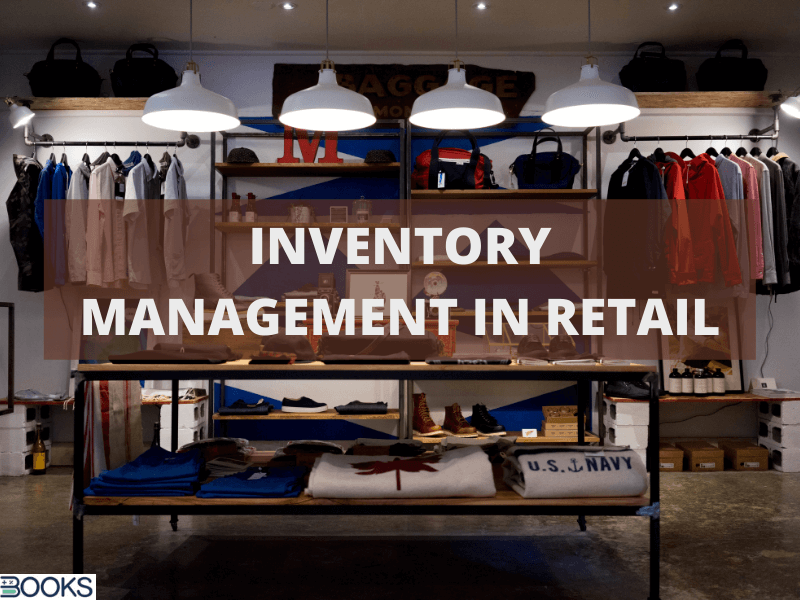
Inventory management in the retail industry refers to stocking the right quantity of the inventory that your buyers want. Also, inventory management looks forward to managing the inventory level meeting your consumer demands that you won’t run out of stock at times and lose your consumers. Moreover, inventory management also focuses that you don’t keep your inventory more than it’s needed, therefore, you don’t overstock your inventory level.
Ideal inventory management in the retail industry aims at overall inventory management from purchasing the right product in the right quantity, pricing methods, receiving, inventory counts, and its location tracking throughout the supply chain.
Are you a retail business owner? Have you lost your customers when the products ran out of stock? Or, have you been in losses due to overstock? Well, whatever you have faced till now, it won’t be the same after reading this article.
Today we will discuss how to do intelligent inventory management in the retail industry throughout the supply chain using our efficient systems and techniques.
Table of Contents
Introduction – Inventory Management in the Retail Industry
In the bygone age, inventory management in the retail industry was comparatively harder for business owners to control their inventory levels and meet the consumer’s demand. Therefore, in today’s technology driving economy, a retail point of sale POS systems like BooksPOS facilitates small retail store owners to manage their inventory faster and more effectively than manual methods.
BooksPOS offers you automated inventory management with real-time sales. Using a POS system, your inventory counts are ultimately adjusted after each sale and all the changes in your accounts, payments, and billing are automated carefully. Thus, enables you to manage your retail at your fingertips.
The best part here is our software includes no additional charges and provide provides 24×7 support.
How inventory management in the retail industry works?
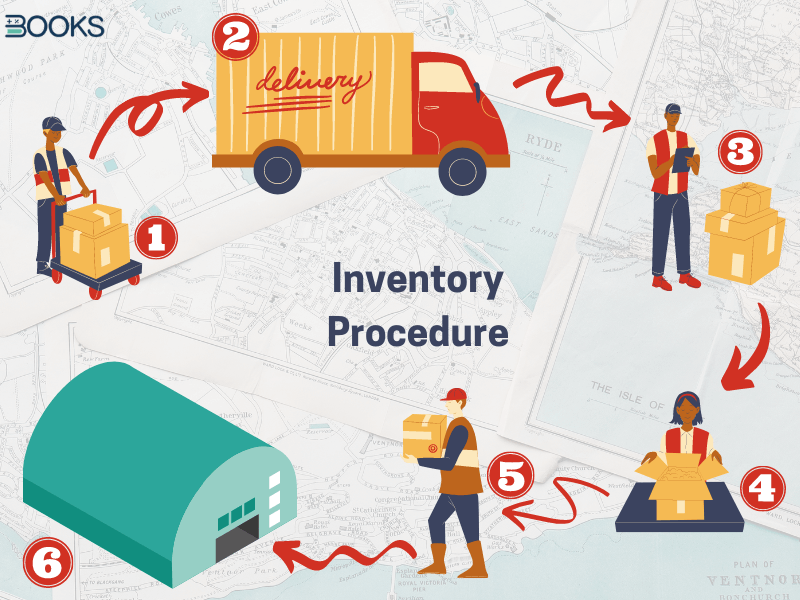
Best practices for inventory management in the retail industry involve the efforts of people, processes, and technology as a whole. For efficient inventory control in your retail, every owner must have a clear mindset for the procedures involved in how to handle inventory-related tasks. For this purpose, the tasks involved in receiving the inventory, cycle counts, and reorder stock should be assigned specifically to skill and professional employees or staff.
Similar to this, the small retail owners should have an efficient and ideal inventory data management system that should be capable to support automated inventory restocking, tracking its location throughout the supply chain until it receives the terminal POS transaction, and warns you when the stock falls below the limit.
An end-to-end POS system like BooksPOS aids small retail owners to make use of all these facilities seamlessly in their inventory management in the retail industry. Moreover, Books POS offers real-time insights for every specific data – from sales to inventory control to each product performance reports.
To know more about how inventory management in the retail industry is processed, Click Here.
Benefits of POS Inventory Management in the Retail Industry
POS system offers you many advantages and benefits for your retail. When compared to a traditional cash register, it can prove a boon for your business.
If you are still using an electronic cash register, and a credit card terminal, you are somewhat lacking behind to grow your business at its best. You must consider upgrading to a point of sale (POS) system for a better experience and comfort. However, if you were hesitating till now, thinking of its price, it’s the best time to go on with a POS system upgrade. POS system is much affordable and easier to use with our BooksPOS in the market by this year.
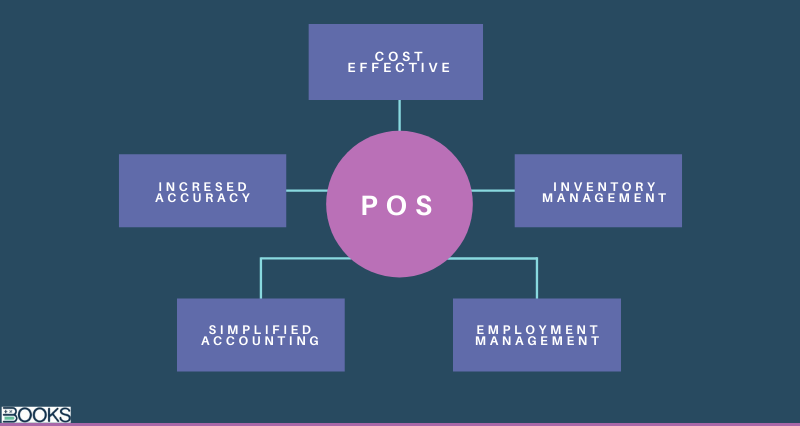
Using a POS system for inventory management in the retail industry, you are benefitted with numerous of advantages at every aspect of your retail workings rather than only at checkouts. It’s the only time to get rid of your bulky cash registers and pathway your growing business with a POS system that offers you the following benefits:
1. Increased Efficiency
The efficiency of your business will increase when your cashiers obtain the right tools that support their working mechanism. A painter cannot paint a house without paint colors and a brush. Likewise, you can’t expect your employees to decrease the checkouts time and manage their work without any human error of you don’t provide them with the right tools for their work, i.e., a barcode scanner and a POS system.
2. Ease of Use
Since the bygone age of manual work is tempting to fall gradually out of use, a POS system has proved to be an innovative and powerful source for your inventory management in the retail industry. Today, everything is made touch screen. Therefore, directing over a touch screen has become a habitual nature for all of us. With an engaging and easy-to-use interface, a POS system offers easy access to all the employees. Moreover, the employees can learn navigating the software easily that aids in reducing training time, and helps to grow the business’ productivity as a whole.
3. Expanded Payment Capabilities
Point of sale benefits also comprises the capability to quickly accept all types of payment methods (including EMV chip cards, contactless payments (NFC), and mobile wallet payments). By proving your customer’s different payment methods, you can increase customer satisfaction. As a fact, a recent study proves that 44 percent of customers make use of debit cards while 33 percent prefer using credit cards.
4. Greater Accuracy
An ideal point of sale system provides an easy-to-use, touch screen interface. Moreover, it helps the cashier or your sales associates to pull the needed informations at times when need at their fingertips. It provides an error-free, computerized accounting, stocking, billing, and payments. Therefore, increases the accuracy of your inventory management in the retail industry. With real-time insights, a POS system helps to improve your business aspect where you are lacking behind.
5. Inventory Management
Though a cash register might not provide you with advanced inventory management in the retail industry, a POS comprises these capabilities. An Ideal point of sale system helps you track your inventory throughout your supply chain, keep a record of inventory sold and bought as well, gives a signal warning as a notification when you run below the inventory level, automates restock, and a retail matrix. The POS system is going to save you from every ups and down faced in your daily inventory level. Withal, the best-appreciated part of this system is that it provides you real-time data – which the best cash register also can’t do.
6. Employee Management
Using a point of sale software, you can reduce the time consumed on drafting and implementing working schedules for employees. A best POS system offers you the feature of clock-in and clock-out functionality for your employees. An ideal point of sale authorizes you to take control measures in order to ensure the employee’s identity verification for clock-ins and access to the system. Moreover, ideal inventory management in the retail industry empowers the employees with access to only those functions on a POS system that an employer wants or authorizes to his employees.
7. Reporting
“If you can’t measure it, you can’t manage it.” This catch-phrase has become the principle for many businesses. It even also makes sense because if you don’t have the right data, there’s no point that you can manage your retail inventory with accuracy.
The POS software keeps you up-to-date with everyday reports. You can keep a close eye on sales patterns, profits gained, and expenses incurred using the data-driven by the POS reports. Moreover, you can also access the reports anytime, anywhere with ease. It doesn’t matters where you’ll be, you can access the data that drives your business decisions anytime you want. Powerful POS software reduces your expenses of employing a record-keeper in your inventory management in the retail industry. Also, you can make accurate and effective adjustments required as per the records drawn by your POS that would help you to maintain your profitability and competitiveness in the market.
8. Simplified Accounting
A point of sale system serves as a pathway to rationalize the accounting process. Using a cash register, it compels the accountants to streamline through hundreds of receipts. Yet, a POS system allows you to print computerized and error-free records. Moreover, an integrated POS system provides you with an aid to import the driven data directly into your accounting software.
9. Detailed Receipts
Ideal POS software uses inventory driven data to provide more information (item number, item description, price, bag discount, savings from a coupon, etc.) to the customers on the receipts. Therefore, it provides the customers with a more detailed receipt rather than just a manual bill – a slip of paper with the date of sale and the price of the item.
10. Faster Service
Do you like to wait in a long line during checkouts? No, right! We too don’t prefer to wait and neither do your customers. Moreover, if the billing counter is equipped with a long line, most of the customers will get frustrated and can even put their items back that they were about to purchase and simply walk out.
POS systems have a solution for this too! With the faster-automated billing features, the checkout time is reduced to its minimum. Moreover, if you are using a barcode scanner with the POS system, it will foster your checkouts and the customers don’t have to wait for too long. Mostly, using a POS system with a barcode scanner, checkout time is reduced to a minimum of 30 seconds per customer. Isn’t it great? Yes, this is the power of a POS system.
Point Of Sale Advantages Don’t End Here
POS solutions can reduce the cost of business operations ensuring to increase productivity and improve your bottom line. Bringing a new life to your store by upgrading from an ECR to a point of sale system leads in a quick return on investment (ROI) – both in dollars and time employed on day-to-day operations. To know more about what good benefits a POS software offers you for inventory management in the retail industry, VISIT PAGE.
BooksPOS for your Retail –
Easy Inventory Management in the Retail Industry
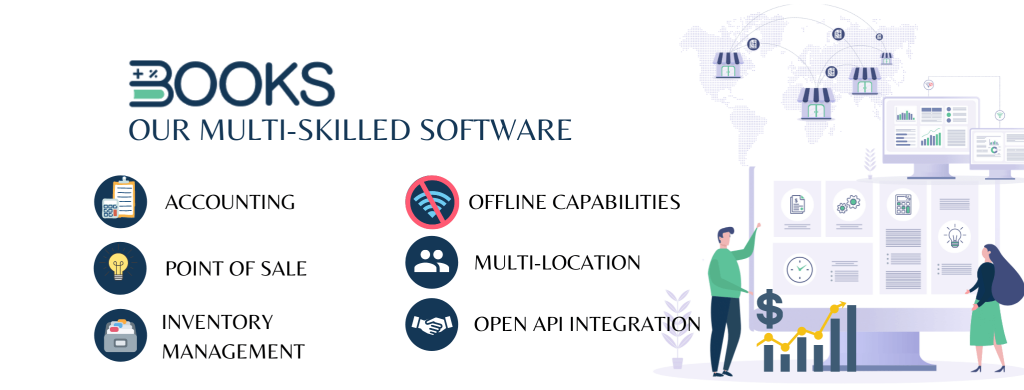
About us
Our BooksPOS software offers you free cloud-based ERP and POS software for inventory management in the retail industry. Using our software you can unify inventories and orders across all your offline stores as well as e-commerce websites like Woocommerce, Shopify, and other marketplaces. It automates your inventory level whenever a sale is made. BooksPOS offers you all-in-one cloud Inventory, POS, Accounting, and e-commerce. Also, it helps you get real-time sales.
Our system is easy-to-use and affordable as well. It allows you to manage all your operations in central, could-based software. It also offers you a semi-integrated secured P2PE (point-to-point encryption) payment opt-ins. Moreover, it provides you to run all your franchise networks of stores seamlessly from any location.
BooksPOS is a deeply integrated and compatible solution that gives you retail-level capability without the traditional costs ascertained with an ERP type solution. No matter how big or small your business is, our system is compatible and has a solution to fit. It is easily scaled to meet your requirements to the best above all.
Features BooksPOS offers
Our retail POS software offers you various features such as,
- Unified Inventory from all across your offline and online stores (Woocommerce and Shopify)
- Franchise Management
- Works Offline
- Customer Loyalty Programs (Coupons, discounts, redeemable points, and so on)
- Automated Finance and Accounting
- Integrations with existing software
Inventory Management in the Retail Industry with Few Simple Steps
Make your inventory management in the retail industry with the best techniques and methods that any retail store requires to adjust their inventory up to its optimum need. Under these steps, we’ll acknowledge how to manage inventory using the best inventory management ways and tools – paper logs, computer spreadsheets, or a POS system that offers a fully integrated inventory, like BooksPOS for your Growing Retail.
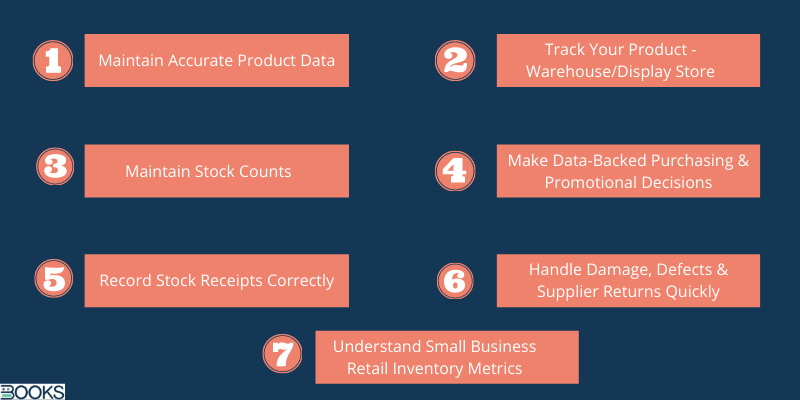
So, here we are with the key procedures for inventory management in the retail industry:
Steps Involved in Efficient Retail Inventory Management
1. Maintain Accurate Product Data
Ideal inventory management in the retail industry initiates with maintaining accurate and proper data for each product that is stocked. Maintaining accurate product data simplifies easy access to any information as to when needed for any inventory management task – reorder stock, evaluate costs, inventory level control, or sales tracking.
No matter what technology you are using – paper logs, computer spreadsheets, or a POS system, you will always require creating a Product Data Management Procedures. Therefore, the product data management procedure covers every aspect of processes and instructions that is a pathway to:
- Record Product Data – Determine where and how the product data is being recorded (paper log, spreadsheets, or a POS system like BooksPOS for your retail outlet). Also, make sure the methods involved in recording and tracking this data.
- Track Product Information that includes main product details like,
- Product name
- SKU
- Variants information (like colors and sizes)
- Price
- Brand name and other item description
- Attached coupons (if any)
- Stock availability
- Packing charges
- Suppliers SKUs and UPC barcode
- Enter New Product Data – Keep a note of whether your new products are entered into your system before or after the actual delivery.
- Handle Product Data Updates – Like the product purchasing and promotional information keep on changing, make sure that you keep your product details updated.
Using a POS system, you can also add product images and descriptions to your product data. Moreover, this will help your customer consultants to solve customer’s product-related queries with ease. Further, it also aids in quicker store checkouts, and integrate products and its information to online e-commerce platforms.
The vital key point that you should always keep in mind is that inventory management in the retail industry requires a complete series of product details, not only just product name, SKU, and stock availability. Therefore, the more information you record, the more will be the ease in handling other retail inventory management task and collecting quick and valuable data.
2. Track Your Product – Warehouse/Display Store
The second step is to make sure where your stocks are lying so that you can properly merchandise and sell them. Most of the time, the products kept in the back of the shelves are forgotten that results in unsold stock, miscounts, ordering excess, and over-stock. This all leads to loss for a small retail owner. However, an accurate stock tracking procedure or system avoids such situations to occur and is easy to handle once your inventory data maintain properly.
There are many ways in which you can track inventory locations in your retail. They are:
- Department or Category Mapping
- SKU (stock keeping unit) Numbers
- Barcode Labels
- Color Codes
- High-tech RFID tagging.
Among all of these methods, the most simpler and preferred by almost every successful retailer is an internal SKU system. Here’s how you can set up an internal SKU system with your department-specific SKU coding:
| 1. Create Master Departments | Create Master Departments for your products to group them on your sales floor. |
| 2. Link these Departments | Link these Departments to the specific display areas on the sales floor. |
| 3. Create a Physical Map | Create a Physical Map of your sales floor and identify these departments there. |
| 4. Assign Unique SKUs | Assign Unique SKUs to each of your products with the departmental identifiers involved in the SKU code numbers. |
| 5. Record SKU | Record SKU as a Product Data while entering product information in your inventory management records or your POS system. |
| 6. SKU Labels | Create or Print SKU Labels. |
| 7. Tag SKU Labels | Tag SKU Labels when you receive your stock. |
| 8. Note stock locations | Note stock locations where the products are over-stocked so that it might not get forgotten. |
| 9. Train your staff | Train your staff to handle the new inventory management system and print the physical layout of the sales floor with all departments for quicker access. |
The main benefit of using SKUs is that it works even without barcode labels. Moreover, it easily operates with any method of inventory management in the retail industry – paper logs, computer spreadsheets, or a POS system like BooksPOS.
Once you start using this method, you can easily access where the products are kept on the sales floor by just a quick glance at an SKU tag. Therefore, it fosters inventory management in the retail industry with easy restocking and tracking. Also, it provides better customer service by providing them with the right product in right place.
3. Maintain Stock Counts
Stock counting is one of an integral part of any inventory management in the Retail Industry. If you don’t consider regular inventory counting, how will you make sure what products you have in stock and in what quantity? Or, does the different inventory methods that you use – paper logs, spreadsheets or a POS system computes a right count that matches what is actually received in the warehouse? Even if you use a computerized POS system, you will need to count your stocks and determine that it actually matches what was ordered.
However, BooksPOS shows you an accurate inventory count but matching that figure with what you actually have won’t be a bad idea. Right? Moreover, inventory counts help you detect suspicion in any case of theft, damage, or less stock delivery by the supplier.
Maintaining stock counts can be done on grounds of any of these inventory counting techniques:
- Cycle Counting
- Perpetual Counting
- Annual Counting
Now, let’s understand how to count stock using these techniques.
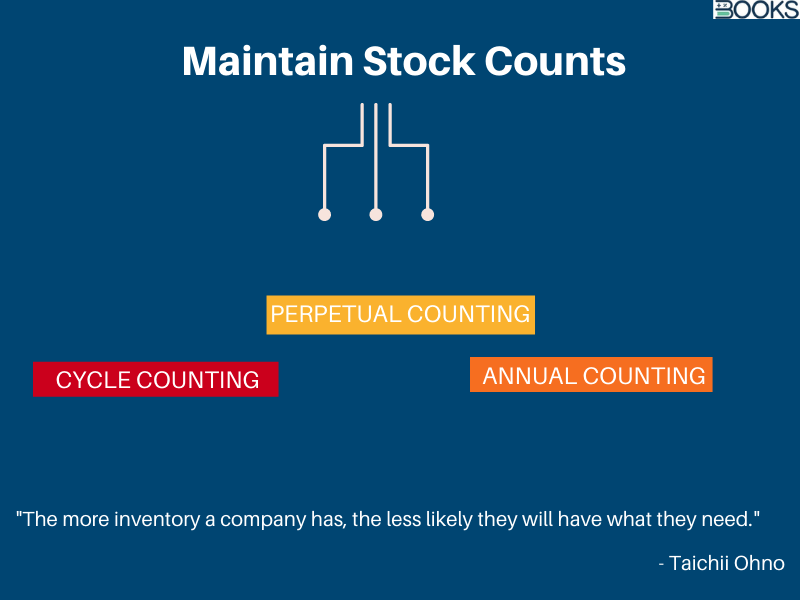
CYCLE COUNTING
Cycle counting is also referred to as Periodic counting. Many successful businesses prefer cycle counting over any other method. Rather than counting their inventory at the end of the year, they rely on cycle counting. You can say each day or a week, or even a month different products are tallied on a rotating schedule. In this process, higher-value goods are frequently counted than lower valued ones. You can count your inventory periodically using any of the inventory management tools:
| Paper Logs or Spreadsheets | A POS System |
| Using a manual inventory management system, if you compromise in adjusting your stock daily or weekly to derive sales patterns, it will ultimately result in a distraction in your inventory turnover ratio. Therefore, you’ll need to use the cycle counting method to derive accurate sales as well as stock quantity whenever you reorder. | When using a POS system like BooksPOS for Retail, stock quantity is automatically updated whenever a sale is made. Therefore, cycle counts become easier when you use a POS system. You just need to spot check stock quantity and tally it with the figures shown by your POS system. |
PERPETUAL COUNTING
This technique is the most preferred and basic for matching the stock when it arrives. In simple words, perpetual counting refers to the counting of the stock as soon as it enters the warehouse or is received by the supplier. Here, the stock manager tallies the stock to what was being ordered before warehousing it. The perpetual counting is done with the help of manual methods – paper logs and spreadsheets.
ANNUAL COUNTING
Annual counting is referred to the counting of each and every stock once in a year. It is mostly done at the end of the fiscal year to find the sales, damaged stock, or unsold stock. Also, it is done for the purpose of tax computation. As it is a store-wide work, the counting of the stock is usually done after the work hours or when the store is closed.
4. Make Data-Backed Purchasing & Promotional Decisions
Once you are done with maintaining product data, inventory tracking, and stock count technique, you are all set to further make purchasing and pricing plans for your goods. Moreover, you can merge your sales data with your inventory counts and result in smart purchasing and promotional/pricing plans. Now, the way you have to do this will depend on what procedure you are using for your stock tracking and sales data – POS system, paper logs, or spreadsheets.
Now, why is the purchasing procedure vital? It is an important step for inventory management in the retail industry. A purchasing procedure outlines the fences for what goods you need to purchase, in what quantity, and how frequent. Moreover, Promotional or Pricing procedures points the slow-moving goods and make promotion plans to sell them out quickly without losing hands with profits. Here, we can explain how you can rely on and create these two procedures – Purchasing procedure and Promotional or Pricing procedure.
CREATE A PURCHASING PROCEDURE
The main aim of purchasing is to buy an apt quantity of stock that covers the sales during a period. Moreover, this procedure ensures that you don’t overstock your inventories by ordering excess that you will ultimately have to price down. This is one of the continuing works in any successful retail industry. The procedure you will rely on depends on what sales tracking and data management methods you are using, therefore, manually through spreadsheets and paper logs or via a POS system that automates your purchasing attributes.
Here, we have elaborated the steps for a retail purchasing procedure:
- Schedule your purchasing time –
Never rush your purchases, it can result in mispurchases. Therefore, try to make aside some time from your busy schedule to decide on purchasing numbers and make smart restock orders.
- Review low inventory numbers –
If you are using a POS system, then you don’t need to worry about missing your low inventory counts. A pos system sends alerts to you whenever an inventory count runs below the desired limit or limit set by you. For paper logs, you can take out your low counts and tally records. If you are using a spreadsheet, you can filter your counts from low to high to determine what inventories are low in stock and by how much. - Run your sales numbers –
Before you reorder stock, first pull out your sales data and review which of your hot selling products are sold endlessly and are in high demand. If you are using a POS system, it will automate it and produce the results for you. However, if you are relying on manual methods like paper logs and spreadsheets, you’ll need to manually have a look and compare.
- Plan your purchases –
The last step in your purchasing procedure is planning your purchases. Strategize your purchasing procedure smartly so that you remain in profit again when you reorder. For this, you should first review the list of hot selling products that are not seasonal and it should be prior, therefore, a higher level in your purchasing list. Further, you need to plan low-level inventory reorders.
Review the stock level and analyze how much time it takes to get sold (sales velocity) and how fast it arrives once ordered (lead time). This is known as Forecasting. Manual methods like paper logs and spreadsheets need to records sales and inventory updates to review them each time you decide to reorder. Yet, a POS system allows you to create quick purchase orders based on the reorder limits you set.
PROMOTION OR PRICING PROCEDURE

While purchasing or reordering to maintain the inventory level of hot selling goods, you also need to keep a check on sales velocity and levels on slow-moving goods too. Slow selling goods should be promoted and priced down to make them sell quickly and free up profits and holding space from them.
Slow selling products comprise:
- Products that are gradually becoming out of trends.
- Seasonal products that are approaching the end of the season.
- Low demand products that are ideal on the shelves.
Yet, you don’t need to worry. You can clear out these slow-moving products with the aid of the Promotion and Pricing Procedure.
- Identify slow-selling products – Review your purchasing records to know what stock is ideal and are slow movers.
- Create Price down schedules – Make a plan to cut the prices over for and by a specific period of time. You can slow discounts, like 10 percent off in the first week, further 20 percent off in another week, and so on.
- Use sales and saving displays throughout your store – Try to engage customers throughout your store by displaying sales or discount displays. This is a good way to grab your customer’s attention to the slow-moving products.
- Create promotions – Social media is one of the biggest sources of promotion these days. You can promote your deals through social media and advertisements. Moreover, you can offer loyalty program promotions for your customers, like buy-one-get-one-free deals and redeemable points on the purchase of specific products.
Healthy inventory management in the retail industry involves discounts and markdowns as a vital part of freeing cash from slow-moving products. Therefore, don’t sit ideal. Use this procedure to keep moving your inventories out and bring in new and fresh goods meeting market trends.
5. Record Stock Receipts Correctly
When you receive your ordered stock, it involves an inventory management technique (recording stock receipts) that a retailer should use from day one only. It’s not necessary that suppliers won’t make a mistake while delivering the goods, they do it simply! Most of the time, you may receive incorrect goods, defective goods, and even have unrecorded backorders. Therefore, a sound receiving procedure is vital to keep a check and record all received goods accurately. Further, detect damage and error that you should tell your suppliers as soon as possible.
Wrong stock receipts ultimately obstruct your inventory counts and that slips down affecting all inventory management tasks. Further, receiving wrong products can sometimes result in surprise overheads for paying for the items that you didn’t order, overstocks, incorrect reorders – all that leads to a decrease in profits. The solution to this problem is to rely on receiving procedures. By doing so, you can relieve yourself from a huge inventory management headaches and overhead expenses that eat up your profits.
Here, we have elaborated the steps involved in your Receiving Procedure:
- Count all units as the order arrives –
Count all the boxes received before opening any of them. Make sure that you received all of the packed units as expected and if not, track those inventories and check whether they are still en route and will arrive as separate.
- Organize your stock –
After you finished counting the stock, unpack the entire boxes, and organize them for a further receiving count.
- Tally received products against your purchase order – After, you are done with organizing your received goods, tally those with the quantity mentioned in your purchase order. This is the most vital step in inventory management in the retail industry. Never depend on your supplier’s stock receipt for correct receiving. If they made any mistake in delivery, it won’t be reflected there, Therefore, check your received goods against your purchase order to ensure that you got what you ordered without any shortages.
- Note errors, shortages, or damages –
Further, in case, you received goods don’t match your purchase order, jot down the errors faced, and send it back to the supplier.
- Update inventory counts for received goods – Adjust the stock counts in your inventory management system that you are using. If you are using a POS system like BooksPOS to grow your business, you don’t need to work manually. The POS system will simply accept the purchase order and further automates the changes in your inventory level. However, if you are using paper logs or computer spreadsheets, you will have to take the pain to make count adjustments in your records manually.
A POS system helps you to label or earmark inventory parts of your receiving procedure for your inventory management in the retail industry. Whenever you receive your ordered stock, your POS system will automatically print your price tag labels set by you. This aids in tagging your goods as it arrives and moves on to the sales floor quickly.
6. Handle Damage, Defects & Supplier Returns Quickly
It is very vital to remove the goods that are ideal and is not sold since the six months from your store or your record books as soon as possible. These unsold goods comprise – damaged goods, low-demand goods, an unsold stock like seasonal goods, unsellable returned goods, and incorrectly shipped goods. Moreover, these goods are often referred to as “Dead Stock”. Deadstock affects the stacking of inventory areas. When the warehouses are stacked with unnecessary dead stocks of unsold goods, it may occupy a large area and soon there is be no place left for the reordered stock.

Therefore, it is very important to make those unsellable goods off your store or warehouse. This could be done when you regularly keep a check on your inventories by counting and adjusting them accordingly.
Here are some steps that you can rely on to handle damage, defects, and supplier returns quickly and keep your shop stacked with wanted and sellable goods.
- Record all spoilage and unsellable customer returns – Maintain a record book of all the inventories that are damaged or are unsellable returns. Further, decide how to deal with these inventories and record it regularly – daily, weekly, or monthly.
- Remove Goods from Inventory Counts – Using a POS system, the unsellable customer’s returns are automated and consequently removed from the stock count whenever a return is made. Moreover, inventories with in-store damages can be removed just-in-time when found or on a regular basis in batches.
- Designate a dead stock holding area – Assign an area in your sales floor or warehouse to hold up the dead stocks or the damaged goods that are unsellable.
- Remove unsellable goods on a regular basis – Don’t let your warehouse stack up with the dead stock without leaving any vacant space for the reordered stock. You should keep your holding apace efficiently managed. Further, you can donate those unsellable though usable goods to local charities return the misshipped or defective goods back to the suppliers.
Purchasing and promotion methods can be a periodic activity for a solo functioning, or even daily for an actively engaged inventory management in the retail industry. The vital aspect here is scheduling the time to deal with these significant inventory management techniques. Moreover, aim to maintain your stock level by filling your holding spaces with more profitable hot selling goods rather than the slow movers.
7. Understand Small Business Retail Inventory Metrics
In the final analysis, your business runs because of profits only. What you perform may satisfy you and your fervor. Yet, you need to earn money to feed yourself and the staff working for you. Therefore, a key factor in inventory management in the retail industry is to realize where your capital is invested, and whether you are making profitable sales with your inventory or not.
To understand this, first, you must know the basic and fundamental business metrics that we have explained further. If you use BooksPOS for your Retail store, we will take care of all your accuracy and will deliver the reports that explain the full history insights.
If you are using paper logs or computer spreadsheets for inventory management in retail, you will have to pull out your calculators and jot down numbers manually. However, for your POS sales insights and inventory reports, you will simply need to set a fixed time aside from your busy schedule to review your POS reports.
PRODUCT PROFITS
First of all, you require knowing the profitability margin of your products. Some products may have a lower profit margin and sell frequently. On the other hand, some may have a higher profit margin and sell gradually. Therefore, you must assure these product data before reviewing your purchasing and promotional needs.
Often, slow-selling products even with high prices can prove too profitable for the business, so marking them down would not be apt. Or, many times hot sellers can have a higher sales volume in business, though it takes a lot of space and also has higher rates of return. Therefore, hot sellers drive less profit when compared to slow movers.
Here a POS system can prove very beneficial for inventory management in the retail industry to track profitable products. Using a POS system, you can easily assess the profits you are making from your every type of product. A POS system provides you the reports of Sales and Cost of Goods Sold (COGS) that shows product profitability for each of your product. Further, you can easily obtain an accurate detail of those products you are making more money with and those that are kept in stock in vain. It also analyzes the total COGS for every product that is sold during the sales period of one week, month, or a year.
If you are not using a POS system, you can ascertain your Cost of Goods Sold (per product or overall) using this formula:
COGS = Beginning Inventory + Purchases during a period – Closing Inventory
If you use our BooksPOS, it automates these math calculations for you and provides you with the ultimate reports to review so that you can take measures for efficient inventory management in the retail industry.
INVENTORY VALUE
It’s convenient to know the amount of cash invested in inventory at any given period of time. Also, this is a significant figure to process accounting. Yet, it also reports how much-intended profits are ideally sitting in your unsold inventory. To calculate inventory value manually via products logs or computer spreadsheets, rely on this formula:
Stock Value = (Item Wholesale Cost + Averaged Inbound Shipping) * Quantity in Stock
INVENTORY TURNOVER RATE
Inventory turnover rate is an important term under inventory management in the retail industry. After your COGS and Average inventory values are extracted, you can move towards calculating your inventory turnover rate, i.e., the rate at which your inventory converts into cash form through sales. To figure inventory turnover, you’ll have to use this formula:
Inventory Turnover = Cost of Goods Sold / Average Inventory
Most of the retail stores calculate the inventory turnover ratio for Inventory management in the retail industry on an annual basis. For example, Store A had COGS of $50,000 and has an average inventory of $6,000 at the end of a year.
$50,000 / $6,000 = 8.3%
Therefore, it has an inventory turnover rate of 8.3%.
Whereas, Store B has a comparatively lower rate of inventory turnover with an average inventory of $10,000:
$50,000 / $10,000 = 5%
Therefore, when calculated on average, Store A made sales of about 8 times from its inventory throughout the year. On the other hand, Store B turned half of his stock into cash – being more cash tied up with the unsold inventory throughout the year.
WHAT THESE NUMBERS MEAN TO YOU?
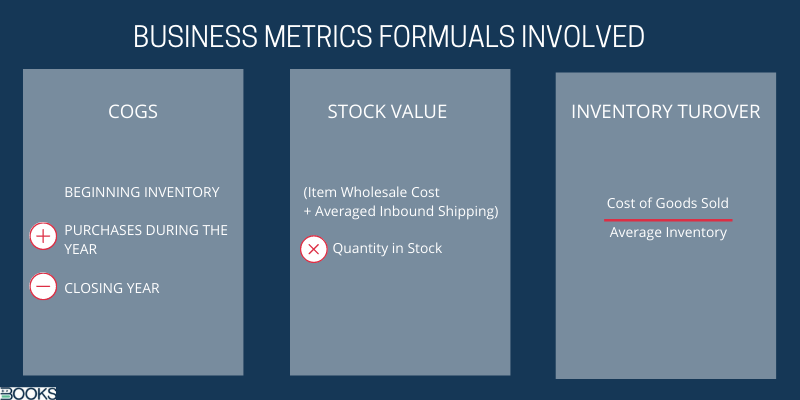
You must be thinking whether these figures are genuinely important for inventory management in the retail industry or not. The answer is, YES! These numbers really mean for better inventory control of your business.
I agree that an inventory turnover rate is just an average number that comprises slow movers, hot sellers, and everything else that comes in between. Yet, it’s a business metric to understand whether you are stocking your inventory properly or not. It aids in ensuring that you’re not overstocking too much stock over time.
With the help of our example, you can see that Store A made a lower investment in his inventory and has more cash-in-hand at the end of the year, while Store B has wasted a lot of money by investing in overstock – that remained unsold over time. This had a huge profitability effect on its sales as most of the profits are sitting with the unsold stock.
Thus, these are some of the best inventory-related business metrics that a successful retail owner should apply in its store. However, these three metrics that we discussed above – Products Profits, COGS, and Inventory Turnover Ratio determines and explains how you’re steering your inventory management in the retail industry.
Bottom Line
Inventory Management in the Retail Industry is vital for smooth operations and effective cash management. It aids to follow inventory management techniques as a set of procedures in order to make sure that the product data management, stock counts, receiving process, and inventory tracking or locating are all administered efficiently and in a quick way.
You can process your inventory management in the retail industry with the above procedures on grounds of whatever management tools you use. You can use paper logs or computer spreadsheets as a manual tool though it can be frustrating. Else, you can use an efficient POS system like BooksPOS as your single system for inventory management in the retail industry that ultimately automates and updates inventory levels as per sales made.
Using a POS system like BooksPOS for your Retail makes it easy in every aspect of inventory management in the retail industry. Moreover, a POS system makes it simple to create efficient procedures from the techniques you rely on. It further integrates inventory data, sales activities, purchase orders, and more within one software and also automates multiple tasks.
See how BooksPOS – Single Retail Management Software can bring a new life to your store and further help you to grow your sales with efficient inventory management in the retail industry.








